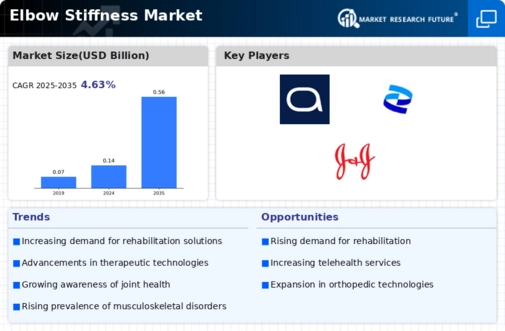Market Analysis
In-depth Analysis of Elbow Stiffness Market Industry Landscape
Understanding the elbow stiffness market requires a thorough understanding of healthcare sector demand, supply, and trends. Elbow stiffness, which inhibits elbow joint mobility, is usually caused by traumas, arthritis, or other medical conditions. Elbow stiffness is rising worldwide, driving up the market. There are several reasons for the growing demand for elbow stiffness treatments. An older population, more sportspeople, and more musculoskeletal issues are among these reasons. Orthopedic technology advances affect the worldwide industry. Innovations in surgical techniques, implant materials, and rehabilitation approaches enhance elbow stiffness treatments and boost market growth. Rising global healthcare expenses are another major concern affecting the sector. The elbow stiffness industry is growing, offering pharmaceutical and medical device companies opportunities. This rise is due to consumers and healthcare systems spending more on musculoskeletal issues. Research and development are helping elbow stiffness companies offer new and improved products. Patients and healthcare professionals' expanding needs are met by innovation. Such developments include less invasive surgery and advanced implants. Elbow stiffness market development depends on patient awareness. Increased patient education on prevention measures, early diagnosis, and accessible treatment options helps market growth by contributing to a proactive approach. Market regulation and health authority approvals are crucial. Changes in laws, authorization for new treatments, and quality requirements affect market dynamics and competition. Pharmaceutical companies, medical device makers, and healthcare providers are collaborating more on initiatives. These collaborations exchange resources, information, and a better elbow stiffness treatment environment to expand the market. Healthcare infrastructure accessibility and availability can affect market dynamics. In locations with significant healthcare infrastructure investment, elbow stiffness diagnostic and treatment rates rise, influencing market trends. Elbow stiffness is affected by the global economy. Economic stability, healthcare budget allocations, and reimbursement regulations affect therapy cost-effectiveness and accessibility, which affect market dynamics. In the elbow stiffness industry, patient preferences and outcomes matter. Patient-centered care and treatment success are driving demand for tailored and efficient solutions. Due to competition, mergers, acquisitions, and strategic alliances affect market dynamics. Market consolidation in the elbow stiffness market may affect product availability, price, and competition.

















Leave a Comment